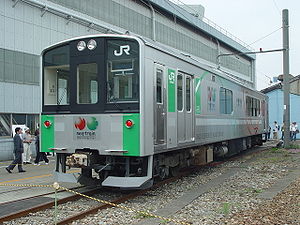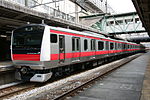- NE Train
-
NE Train
"NE Train" in its first incarnation as diesel/battery hybrid KiYa E991-1, May 2004In service 2003–Present Manufacturer Tokyu Car Corporation Number built 1 vehicle Formation Single car Operator JR East Specifications Car body construction Stainless steel[1] Car length 20,000 mm Width 2,800 mm Height 3,655 mm Doors 2 pairs per side Maximum speed 100 km/h Electric system(s) 1,500 V DC Current collection method Overhead catenary Gauge 1,067 mm (3 ft 6 in) The "NE Train" (NEトレイン) (New Energy Train) is an experimental railcar which has been used to test a number of alternative power sources by the Railway Technical Research Institute (RTRI) and East Japan Railway Company (JR East) in Japan.[2]
Contents
History
KiYa E991 diesel/battery hybrid railcar
The "NE Train" was first delivered from Tokyu Car Corporation in April 2003, configured as the world's first hybrid diesel/battery railcar[3] and classified as KiYa E991-1. The stainless steel bodyshell was derived from the E127-100 series EMU design, with cabs at either end and no gangways.[1] From 6 May 2003, it was tested on the Nikkō and Karasuyama Lines.[4] Data obtained from these trials was used to develop the KiHa E200 DMU, which entered service on the Koumi Line from July 2007.[1]
KuMoYa E995 fuel-cell/battery hybrid railcar
The "NE Train" underwent modifications in 2006 to replace the diesel generator with a hydrogen fuel cell, becoming the world's first fuel-cell/battery hybrid railway vehicle, classified KuMoYa E995-1. The vehicle was fitted with six hydrogen tanks (with total capacity of 270 l) and lithium-ion batteries with increased storage capacity (19 kWh) compared with the earlier KiYa E991 hybrid version. These powered two 95 kW traction motors. The railcar was based at Nagano depot, and tested on JR East mainlines in the Nagano area during fiscal 2007 at speeds of up to 100 km/h.[5]
KuMoYa E911 series battery railcar
The "NE Train" again underwent modifications at Tokyu Car Corporation's factory in Yokohama in 2009, with the addition of a pantograph and storage batteries replacing the earlier fuel cell, and becoming the E911 series battery railcar, branded "NE Train Smart Denchi-kun" (NE Train スマート電池くん). This railcar has a maximum service speed of 100 km/h and can operate on battery power alone a distance of up to 50 km away from an overhead power supply.[6]
The railcar was test-run within Ōmiya Works from October 2009, with test running on the Utsunomiya Line under consideration from January 2010.[7][dead link]
The unit was modified in August 2011, with one of the four lithium battery units relocated beneath the passenger seats, increasing available space.[8]
References
- ^ a b c プロトタイプの世界 - Prototype World. Japan: Kōtsū Shimbunsha. December 2005. ISBN 4910065141258.
- ^ JR全車輌ハンドブック2006 [JR Rolling Stock Handbook 2006]. Japan: Neko Publishing. 2006. ISBN 4-7770-0453-8.
- ^ ""世界初のハイブリッド鉄道車両! 「NEトレイン」 [World-first hybrid rail vehicle "NE Train"]". Japan Railfan Magazine (Japan: Kōyūsha) 43 (506): p86. June 2003.
- ^ "JR東日本 キヤE991系"NEトレイン" 日光線試運転中 [JR East KiYa E991 "NE Train" test running on Nikkō Line]". Tetsudō Daiya Jōhō (Japan: Kōtsū Shimbun) 32 (231): p72. July 2003.
- ^ ""世界初の燃料電池ハイブリッド車両 クモヤE995形 [World-first fuel-cell hybrid rail vehicle KuMoYa E995]". Japan Railfan Magazine (Japan: Kōyūsha) 48 (561): p.53–55. January 2008.
- ^ "「蓄電池駆動電車システム」の開発を進めています [Development of battery-powered train system]" (in Japanese) (PDF). JR East press release. Japan: East Japan Railway Company. 6 October 2009. http://www.jreast.co.jp/press/2009/20091005.pdf. Retrieved 30 August 2011.
- ^ "JR East developing battery-powered trains". Daily Yomiuri Online. Japan: Yomiuri Shimbun. 8 October 2009. http://www.yomiuri.co.jp/dy/national/20091008TDY02306.htm.
- ^ "JRが改良版蓄電池車両を公開 [JR shows off modified battery vehicle]" (in Japanese). Shimotsuke Original Online News. Japan: Shimotsuke Shimbun. 26 August 2011. http://www.shimotsuke.co.jp/news/tochigi/top/news/20110825/596158. Retrieved 30 August 2011.
External links
- JR East press release announcing "NE Train" fuel-cell hybrid programme (11 April 2006) (Japanese)
- JR East press release announcing "NE Train" battery railcar programme (6 October 2009) (Japanese)
Electric Multiple Units of East Japan Railway Company DC commuter/suburban DC express/limited express AC/DC commuter/suburban AC/DC express/limited express 451 · 453 · 455 · 457 · 483 · 485 · 489 · 583 · 651 · E653 · E655 · E657AC commuter/suburban 701 · 715 · 717 · 719 · E721AC limited express E751Non-revenue/experimental This list shows all JR East EMUs, both active and withdrawn, including those inherited from JNR. Shinkansen types are omitted. Categories:- East Japan Railway Company
- Electric multiple units of Japan
- Diesel multiple units of Japan
- 2003 introductions
Wikimedia Foundation. 2010.



